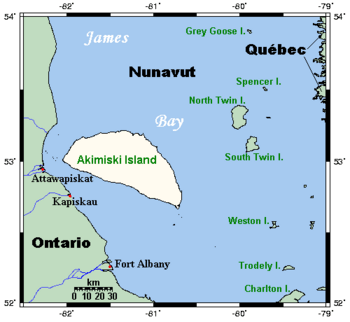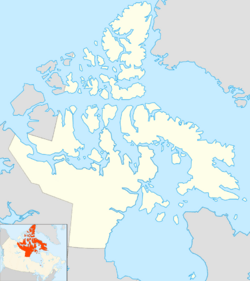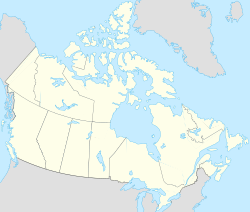South Twin Island (Nunavut) facts for kids

A map showing South Twin Island and nearby areas, Hudson Bay, Nunavut
|
|
| Geography | |
|---|---|
| Location | Northern Canada |
| Coordinates | 53°10′N 79°50′W / 53.167°N 79.833°W |
| Archipelago | Canadian Arctic Archipelago |
| Administration | |
|
Canada
|
|
| Territory | Nunavut |
| Region | Qikiqtaaluk |
| Demographics | |
| Population | Uninhabited |
South Twin Island is a quiet, uninhabited island found in the chilly Arctic region. It sits in the middle of James Bay, which is a large body of water connected to Hudson Bay. This island is part of Nunavut, a territory in Canada.
South Twin Island has a bigger "twin" island nearby, called North Twin Island. North Twin Island is about 10 kilometers (6 miles) to the northwest. Both islands are often called the Twin Islands because they look quite similar.
Contents
Discover South Twin Island
South Twin Island is a unique place with a special kind of landscape. It has a lot of mossy tundra, which is a type of land where the ground is frozen for most of the year. Because of this, there are fewer trees on South Twin Island compared to its northern twin.
Geography and Location
This island is located east of Akimiski Island, another island in James Bay. Its exact spot is 53 degrees North and 79 degrees West. Being part of the Canadian Arctic Archipelago, it's surrounded by cold waters and has a climate typical of the Arctic.
Wildlife on the Island
Even though no people live on South Twin Island, it's a very important home for many animals. It's especially known as a key breeding spot for certain birds.
Bird Breeding Ground
South Twin Island is a crucial place for birds to lay their eggs and raise their young. Two important bird species that use the island for breeding are the Canada geese and semipalmated plovers. These birds travel long distances to come to the island, finding it a safe and suitable place for their families.



